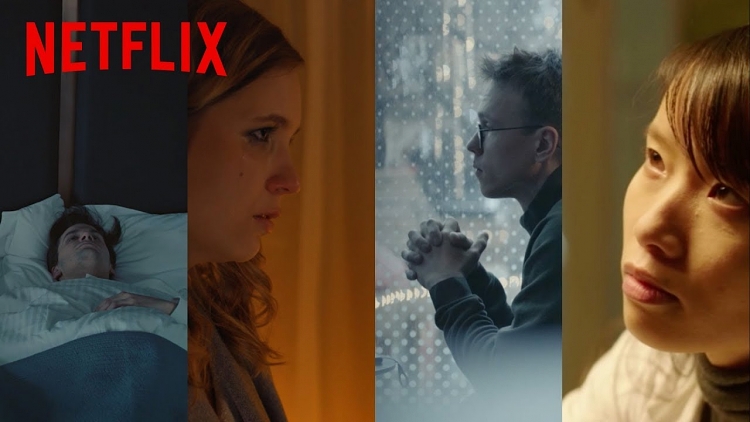Black Mirror’s fourth season came to our screens just in time to ruin everyone’s New Year with its trademark mix of technological terror and paranoid pessimism. Charlie Brooker’s latest offering featured all-female leads, self-driving pizza trucks that are now a reality and a plethora of pop culture and intertextual references. Perhaps — like me — you were disappointed by Season 4’s over-reliance on using brain implants as a plot device in almost every episode. Or maybe you simply can’t wait to stream the recently-announced Season 5. Either way, if you’re eager to get a taste of a new iteration of Black Mirror, wait no longer: there’s a subtitled Polish version of the series ready to stream on YouTube.
In Poland, the original Black Mirror is called Czarne lustro. The Polish-language version was released under the title Czarne lusterko (‘little Black Mirror’) to differentiate it from Netflix’s main anthology. The Polish episodes bear many of the hallmarks of Brooker’s creation. They’re cut from identical thematic cloth, with relationships, technology and bleak endings taking centre-stage. They also feature the same title sequence, musical cues and a certain song that has run through every season to date.
Czarne lusterko is an official production from Netflix’s Polish branch (Netflix Polska). Last year, Netflix’s Central and Eastern European social team invited several Polish YouTubers to create a set of short films inspired by the dark and disturbing mood of Black Mirror. The project lead, Jacek Ambrosiewicz, focused his attention on well-known Polish creatives who produce high-quality content on their social media channels. The end product is four shorts ranging from eight to twenty-one minutes long. They premiered on Netflix Polska and the creators’ YouTube channels earlier this year.
Krzysztof Gonciarz, a travel and lifestyle vlogger who runs TOFU Media, worked on The Breakup, an episode that blurs reality and fiction by dealing with the ability of popular vloggers to manipulate and influence emotions. Comedy sketch-maker Martin Stankiewicz directed The Sum of Happiness, a critique of the increasing reliance on wellbeing apps. Science channel emce kwadrat were the team behind 69.90, which takes a brief glimpse at loneliness in an era of immersive video gaming. And GF Darwin, a satirical web series studio, created the sucker-punch bioethics shocker 1%.
The YouTubers behind the episodes all create different content, most of which is much lighter than your regular Black Mirror near-future nightmare. As a result, each episode transplants the creators’ usual themes and styles into the familiar dystopian universe. “There are certain recurring elements in Black Mirror, such as future technology being used in an extreme way which often leads to negative consequences,” Huyen Pham and Marcin Nguyen explain. They discussed around twenty different possibilities before settling on an idea for their episode 69.90. “The one concept that we liked in particular was about an advanced AI and a computer simulation that is indistinguishable from real life.” The episode looks at the intersection of loneliness and gaming, a pertinent topic that the main series hasn’t yet explored.
In The Breakup, Krzysztof Gonciarz also steered away from typical sci-fi elements. He tells me that he used the Black Mirror episode Shut Up and Dance as a benchmark for how realistic his episode would be. “We wanted to depart from the usual formula of ‘so there’s this new start-up that does this disturbing thing’,” he says. As a result, his episode is grounded in an everyday environment and, like the original debut episode The National Anthem, uses ordinary technology to explore mass psychology. In a neat visual move, Gonciarz mirrors the episode’s vlogging subject matter in its cinematographic style. “I wanted the episode to be a kind of a clash of cinematic and vlog aesthetics,” he recalls. “About half of the movie was filmed with an Arri Alexa Mini — a proper film camera. The other half was done on a Lumix GH5 — a vloggy classic.”
The above two episodes represent an entirely plausible present, but Czarne lusterko is also comfortable imagining as-yet undiscovered technologies. The Sum of Happiness episode combines the series’ classic tropes of neurological implants and relationship apps, whereas 1% proposes a development in obstetrics technology that leads to a worryingly deterministic form of healthcare. Its co-writer and executive producer, Marek Hucz, tells me that humanity’s deification of technology can only lead to a tragic end. “This is probably not just theoretical anymore, or just a vision of the future, but rather the image of our present day,” he says. “We wanted to show that technology can also be fallible, and its ruthlessness and lack of emotion can be the cause of a tragedy.”
Although 1% imagines an alternate reality, its key idea — that a young couple are deprived of control over their life — has a universal appeal. This is reflected among all of the episodes, which are connected by the thread of contemporary societal issues. For example, 69.90 highlights concerns about the adverse effects of virtual reality and micro-transactions, which resonated with its viewers. “We received several messages from people that wrote to us after watching the episode,” Pham and Nguyen recount. “They said they felt that they were watching a production about themselves and wanted to make a change in their lives.”
This resonance with reality feels particularly prominent in The Breakup, which features Gonciarz and one of his YouTube collaborators, Kasia Mecinski, playing lifestyle vloggers — essentially versions of their real selves. In an age of Insta-fame, where subscriber numbers mean everything, Gonciarz suggests that it’s increasingly common for social media personalities to deceive their audiences. “I think in many ways our episode is out-shined by real life,” he says. “What Jake and Logan Paul are doing online is much more dystopian than anything we could have come up with in this sphere.
You can watch all of Czarne lusterko on YouTube now. Be sure to have a look at its beautiful poster art too. Oh, and follow Richard on twitter here.




